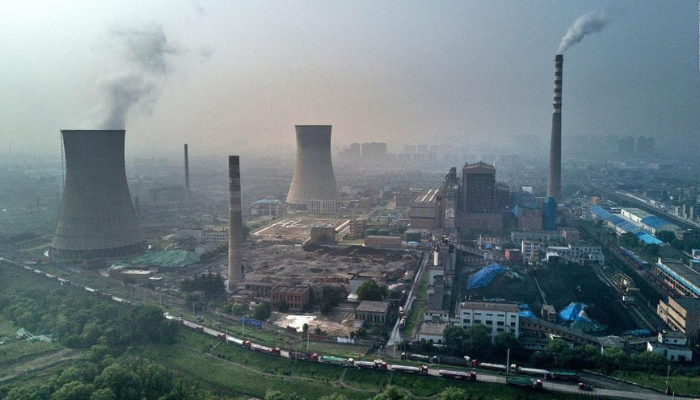
Despite significant advancements in clean energy output, the carbon intensity of the country’s economy remains high
China is falling short of its 2025 climate targets, despite clean energy leading economic growth. The country’s rapid growth has slowed, prompting a shift in focus. While renewable energy has been supported, stimulus funds are still directed towards construction, manufacturing, and coal power. Total energy consumption rose by 5.7% in 2023, surpassing GDP growth for the first time since 2005. China’s economy grew by 5.2% last year, a slower rate compared to previous years.
Despite a slowdown in economic growth, carbon dioxide emissions in China have continued to increase. This is because the country’s economic expansion during and after the Covid-19 pandemic has been highly energy-intensive. Between 2021 and 2023, CO2 emissions grew at an average rate of 3.8% per year, compared to 0.9% per year between 2016 and 2020, despite a slight slowdown in GDP growth over the same period.
An analysis by Lauri Myllyvirta, a lead analyst at the Centre for Research on Energy and Clean Air (CREA), published in Carbon Brief, highlights China’s challenges in meeting its 2025 climate targets under the Paris Agreement. These targets include increasing the share of non-fossil energy sources to 20% and reducing the carbon intensity of the economy by 18%. Carbon intensity measures the grams of CO2 released to produce a kilowatt-hour of electricity.
However, according to Myllyvirta’s analysis, China is significantly off track in achieving these targets, primarily due to the carbon intensity of recent economic growth. To meet the government’s 2025 target, CO2 emissions will need to decrease by between 4% and 6%, as predicted by Myllyvirta.
To meet its government carbon intensity targets, China would need to reduce its CO2 emissions by 4-6% by 2025
The issue partly arises from the government’s response to the Covid-19 pandemic, where stimulus measures were directed towards the construction and manufacturing sectors. This has led to a “shift in the pattern of growth into a more carbon-intensive direction,” explained Myllyvirta. In contrast, many other countries focused their stimulus efforts on households, leading to increased demand for consumer goods and an export boom from China.
Myllyvirta noted that it is not impossible to reverse these distortions in the economic structure. He suggested that combined with the push for clean energy, such changes could lead to a rapid reduction in emissions.
Approximately one percentage point of China’s CO2 emissions growth last year was attributed to the manufacturing of clean energy technologies, such as solar PV, electric vehicles, and batteries. While these products will ultimately contribute to a net decrease in emissions, some of this reduction will be experienced outside China through exported goods.
Understanding China’s energy transition is challenging due to the global significance of the numbers involved in every sector. Despite commissioning as much solar PV in 2023 as the entire world did in 2022, according to the International Energy Agency, China’s rapid growth in energy demand in recent years has surpassed the additions of clean energy.
To achieve the 2025 target, energy production from non-fossil sources would need to grow by over 11% annually, compared to the current rate of 8.5% for renewable energy. In 2023, clean energy contributed $1.6 trillion (£1.26 trillion) to China’s economy, representing all the growth in investment.
Regarding the goal of reducing the carbon intensity of China’s economy by 18% by 2025, the country has only achieved a 5% reduction since 2020. This means that CO2 emissions will need to decrease in absolute terms from 2023 to 2025 to meet the target.
China is falling behind in meeting its energy intensity targets following an annual increase in 2023
According to the National Energy Administration, China’s renewable energy installed capacity surpassed 1.45 billion kilowatts in 2023, representing over half of the country’s total installed power generation capacity.
However, a separate report published by CREA and Global Energy Monitor on Thursday revealed that China approved 114 gigawatts (GW) of coal power in 2023, up from 104 GW in 2022. China’s share of global coal emissions exceeded 64% in 2023.
Despite Xi Jinping’s pledge in 2021 to “strictly control” new coal power, the approval of new coal plants has actually increased rapidly. Nearly half of the growth in power generation between 2020 and 2023 came from coal. This is partly because some thermal power developers and government officials view this decade as a period where CO2 emissions can continue to rise before peaking in 2030, as promised by Xi. Nonetheless, China is widely anticipated to meet this target by 2025.
Local governments, especially those in mining provinces, frequently depend on investments in coal mines and thermal power plants to boost their GDP.
Myllyvirta stated, “The significant increase in coal consumption and approvals of new coal power plants since President Xi’s pledges in 2021 contradicts the commitments – China must take decisive action in 2024-25 to avoid failing to meet them.”



